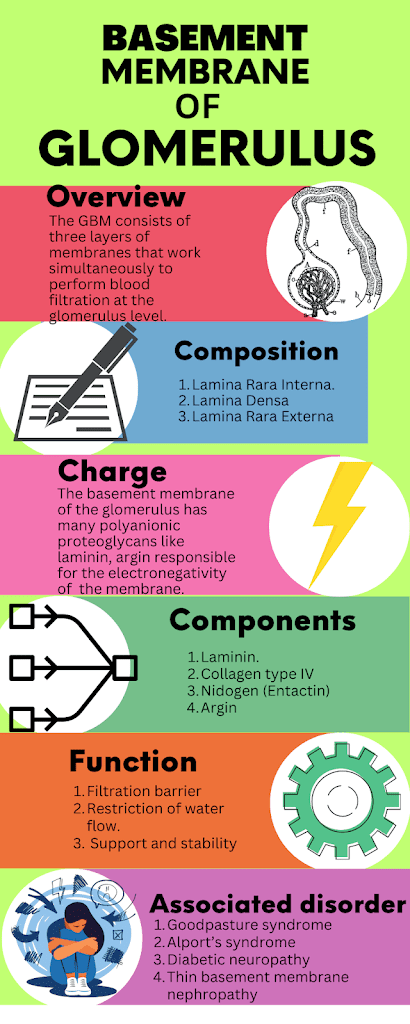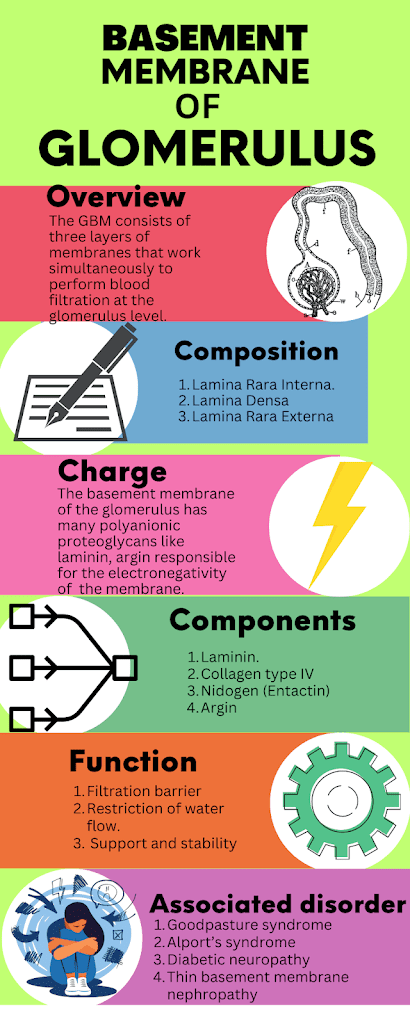OVERVIEW:
The Glomerular Filtration Membrane consists of three layers of membranes that work simultaneously to perform blood filtration at the glomerulus level, which helps in the flow of solvents in blood along with small solutes. At the same time, it is responsible for inhibiting the flow of large plasma proteins through it. Glomerular Filtration Membrane consists of an endothelial layer, fenestrations between their cells, a highly complex extracellular Basement Membrane Glomerulus, and the visceral epithelial cells along with the foot processes. The filtrate then moves to the distal convoluted tubule, where the process of tubular reabsorption is completed.
In this article, I will chiefly discuss the basement membrane of the Glomerulus, its composition, and how it contributes to the Glomerulus’s filtration cascade.
The basement membrane Glomerulus (BMG) is assumed as formed through the endothelial cells layer and visceral epithelial cells layer (podocytes). It is infused in between both the upper and lower layers of cells.
COMPOSITION OF BASEMENT MEMBRANE GLOMERULUS (BMG):

Under the electron microscope, the Basement membrane Glomerulus itself consists of connective tissues and possesses three layers:
Lamina Rara Interna:
This layer is present just beneath the endothelial layer of the glomerular capillaries network. It is composed of proteoglycan called Heparan Sulphate. This layer of the basement membrane is selectively permeable, allowing the entrance of molecules based on charge on it.
Lamina Densa:
It is the central layer of the basement membrane glomerulus, and as the name indicates, it is shown as dense under the electron microscope. It comprises Collagen type IV, three alpha chains joined together to form a triple helix. The area of Lamina Densa allows the entry of molecules based on molecular weight >70kDa.
Lamina Rara Externa:
- It is the layer of the basement membrane of the Glomerulus, which is adjacent to the visceral epithelial layer of Bowman’s capsule and podocyte foot processes. It is mainly comprised of Heparan Sulphate and Sialoglycoproteins.
- Heparan Sulphate is responsible for the anionic-based entry of molecules, while Sialoglycoproteins help to adhere cells together.
CHARGE OF THE BASEMENT MEMBRANE OF GLOMERULUS:
- The supra structure of the Basement membrane of the Glomerulus, which is composed of collagen type IV molecules, as we discussed earlier, possesses a lot of important polyanionic Heparan Sulphate Proteoglycans, including laminins, fibronectins, perlecan, and agrin, are responsible for the electronegative charge throughout the basement membrane.
- Here it is important to note that the electronegativity is not only limited to the Basement Membrane of the Glomerulus instead, the endothelial layer of glomerular capillaries and epithelial cells of the visceral epithelium due to the presence of Sialoglycoproteins. So we can say that the whole filtration membrane possesses electronegativity in it.
MAJOR COMPONENTS OF THE BASEMENT MEMBRANE OF THE GLOMERULUS:
The glomerulus basement membranes comprise four polypeptide molecules:s Laminin, type IV collagen, nidogen, and heparan sulfate proteoglycan (Argin). These are considered the crucial components in the formation, function, and coordination with the other layers of the Glomerular Filtration Membrane.
It is also important to remember that the gene mutation encoding these components can cause various renal disorders.
LAMININ:
- Laminin is the fundamental component of the basement membrane of the Glomerulus found all over the membrane.
- All Laminin found in the human body is secreted as alpha (α), beta (β), and gamma (γ) chains, and these chains bind through the disulfide bonding.
- Different Laminin isomers have other arrangements of αβγ chains arrangement; depending upon this, they have different isomers.
- The typical molecule of Laminin represents cross-shaped chains clustered together through the Laminin-coil-coiled (LCC) domain.
- The Laminin of the Basement Membrane of the Glomerulus has chain arrangement α5β2γ1, referred to as laminin-521 or LM-521.
- It is assumed that the reduction in the Laminin level can cause glomerular proteinuria, hematuria, and, eventually, polycystic kidneys and renal failure.
COLLAGEN TYPE IV:
- Type IV collagen is a trimeric extracellular matrix protein consisting of α chains that are rich in Gly-X-Y amino acid triplet. These alpha chains coiled each other to form a triple helix.
- At the interval of every third position -GLY- is a must because it is the only amino acid chain that has a small end enough to fix at the center of the helix.
- When the glomerular capillaries start mature and physiologically active, the visceral epithelial layer (podocytes) start to secrete α3α4α5 trimers. These then polymerize to form the mature GBM collagen IV network,
- Mutation in the genes that encode the Collagen type IV α3α4α5 can cause defective Basement Membrane Glomerulus.
- These defects can be moderate, as in ”Benign Familial Hematuria” and much more severe, as in ”Alport Syndrome”.
NIDOGEN (ENTACTIN):
- These two proteins, i.e., Nidogen-1 and Nidogen-2, have a dumbbell in shape.
- They are also pervasively scattered in the basement membrane of the Glomerulus.
- Nidogen-1 is considered a connection unit that helps to bind Laminin and Collagen type IV together, and it is also helpful in the formation of a healthy Basement Membrane of Glmerulus.
ARGIN:
- Argin is an essential Heparan Sulphate proteoglycan of Basement Membrane Glomerulus.
- Argin has a huge electronegativity due to Sulfated Glycosaminoglycan (GAG) side chains. Argin itself is the main contributor to the net negative charge of the Basement Membrane of the Glomerulus.
- This negative charge barrier is significant in the prohibited plasma albumin transport across the membrane as both will highly repel each other.
HOW DOES THE BASEMENT MEMBRANE OF THE GLOMERULUS WORK?
- When there is the entry of fluid from the Afferent Arteriole, it comes to the endothelial cells of capillaries of the Glomerular filtration membrane, which have pores or fenestrations diameter is about 60 to 80 nm, so the fluid, along with its solutes, pass through this membrane, and entry to the basement membrane of the Glomerulus.
- Here, it is essential to remember that the molecules exceeding 60 to 80nm diameter will stay here and not enter the BM of the Glomerulus.
- There is a supra structure of collagen type IV of the Basement Membrane Of the Glomerulus, which has a dense area and an electronegative charge. The fluid passes through it along with the solute molecules. Due to the negative charge on the basement membrane, the molecules that possess a negative charge, like some plasma proteins (Albumin, fibrinogen), are strongly repelled at this point.
- So we can say that the movement of the molecule through the basement membrane depends not only on the size barrier but also on the charge.
- Now the fluid reaches the foot processes of the endothelium. Between each epithelium cell, there is a slit called a diaphragm made of a protein called nectin which is responsible for allowing the transport of solutes that have a diameter of 20 to 30 nm.
- Red blood cells (RBCs), white blood cells (WBCs), and platelets cannot pass through a healthy glomerulus due to their large size. The various plasma proteins, including Albumin, globulin, and fibrinogen, also have a size barrier restriction.
- On the same side, one of the plasma proteins, Albumin, has the same diameter as the fenestrations of endothelial cells. So it can pass through the fenestrations of endothelial, type IV collagen of the basement membrane of Glomerulus, and the slits of epithelium, but still, they are impermeable to the filtration membrane. What is the reason???
- Yes! The answer is the charge of the molecule. All plasma protein in the body ph is highly electronegative. Hence, Albumin also has a negative control, and it becomes a strongly repulsive reaction from the electronegativity of all membranes of glomerular membranes, particularly the basement membrane of the Glomerulus.
- So practically, despite being the same size in a healthy kidney, Albumin cannot pass in the filtrate due to high repulsion through membranes.
Functions of the Glomerulus Basement Membrane:
1. Filtration Barrier:
The glomerular Basement Membrane is a unique extracellular matrix between the glomerular filtration barrier and is responsible for facilitating small solute molecules simultaneously. It also inhibits the flow of plasma macromolecules like albumin, globulin, etc.
2. Restriction of water flow:
It is considered the leading site for restricting water flow.
3. Support and Stability:
Beyond being a guard, it provides handy and physiological support to the endothelium layer and the podocytes.
Disorders associated with glomerular basement membrane:
1. GOODPASTURE’S SYNDROME (Anti-GBM):
It is an immunity-mediated disorder in which the body mistakenly attacks the basement membranes of the kidney’s nephron and the lungs, leading to pulmonary hemorrhage. The specific target site for the antibodies of the body’s immune system is the alpha-3 chain of the type IV collagen.
2. ALPORT’S SYNDROME (Hereditary Nephritis):
It is a genetic disorder with deprivation in kidney function, presbycusis (loss of hearing), and visual abnormalities. Patients with the disease show hematuria, edema, and hypertension. A mutation in the gene encodes type-IV collagen of the basement membrane.
3. THIN BASEMENT MEMBRANE NEPHROPATHY (TBMN):
It is also known as benign familial hematuria associated with the diffuse thinning of the basement membrane of the glomerulus. The key symptom of the disorder is hematuria along with proteinuria. There is a mutation in the type IV collagen alpha 4 gene.
4. DIABETIC NEPHROPATHY:
The thickening of the basement membrane of the glomerulus characterizes it. The extracellular matrix surrounded by mesangial cells starts expanding, and loss of glomerular permeability results in microalbuminuria. It is produced as a consequence of increased synthesis of type IV collagen following hyperglycemia-induced alteration of the pattern of podocyte–integrin expression, decreased expression of matrix metalloproteinases (MMP-2 and 3), and increased expression of tissue inhibitor of metalloproteinase (TIMP).
Conclusion:
The study of the Basement Membrane Glomerulus, along with its anatomical concerns and cellular formation, is crucial for understanding the process of filtration that occurs in the Glomerulus and subsequently in the whole urine formation method.
Scientists are on a quest to better understand the glomerulus basement membrane. They’re learning how it works and how to keep it healthy. This will lead to better treatments for kidney troubles and keep us all feeling our best.
In a nutshell, the glomerulus basement membrane is a vital guardian of your kidneys. It’s a humble hero that deserves attention for keeping you healthy.

1 thought on ““Basement Membrane Glomerulus Decoding: Basic filtration station of nephron”